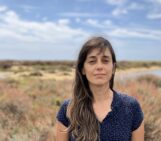
Since 1998 the American Geosciences Institute has been running an annual celebration of all things geoscience – Earth Science Week. From its inception, Earth Science Week has grown in popularity and is now celebrated across the planet. This year Earth Science Week will run from 11 to 17 October and the theme of the week is “Earth Materials in Our Lives.” As the American Geosciences Institute say on their website:
The coming year’s event will focus on the ways that Earth materials impact humans — and the ways human activity impacts these materials — in the 21st century.
For EGU, although every one of our Divisions does work that relates to this idea, this theme ties very closely with the work of one of our Divisions, the Energy, Resources and Environment Division (ERE). Our EGU Head of Media and Communications Terri Cook, spoke to the deputy Division President Viktor Bruckman, to find out his thoughts about how Earth’s materials impact humans and what this means for the Energy, Resources and Environment Division.
What is the Energy, Resources and the Environment Division?
Energy, Resources and the Environment is among the most interdisciplinary divisions within EGU. Our members work on issues around natural (geoscience) resources, exploration, and the development of renewable energy of all kinds (wind, hydrological, solar, geothermal, biomass).
Why does the Energy, Resources and the Environment Division include ‘Environment’ and not just Energy & Resources?
Because an important focus of our division is to assess the impacts of resources exploration and energy generation on our environment. This can be linked to climate change, biodiversity and Agenda 2030, for instance.
Why is interdisciplinarity needed to meet the challenges of providing reliable and affordable supplies of energy and other Earth resources?
Because we are investigating natural systems. A systems approach typically includes various scientific disciplines to assess specific problems. Such problems (e.g. generation of renewable energy) are not trivial and need interdisciplinary research.
Regarding the Earth Science Week theme: What are some of the future challenges of providing reliable and affordable supplies of Earth materials?
This has several aspects: First of all, there is a strong political influence here, and this is associated to equal distribution of Earth materials. The second dimension is the efficiency of its use (less material consumption, more cascading use or recycling) and the third dimension is extraction with low environmental impact. It needs to be mentioned that I am talking about materials that are typically non-renewable resources (at least in human time-scales).
Interview by Terri Cook, EGU Head of Media and Communications
During Earth Science Week itself, we are going to be sharing resources from the blogs of many of our partner societies, such as AGU, the Geological Society of London and GSA, as well as our own blogs, looking at an A-Z of how we can think about the ways that Earth materials are present in our lives.
If you want to get a head start, take a look at the full list now!
A is for Aquifer
EGU Geolog – The art of characterising aquifers.
B is for Bio-engineering
AGU Landslide blog – Eco-Safe Roads – resources to guide construction
C is for Copper
EGU GMPV Division blog – Zdenĕkite, way too pretty to mine
D is for Diamond
AGU Third Pod from the Sun – (Hope) Diamonds are Forever
E is for Evaporites
F is for Fracking
Geological Society of London blog – Let’s talk about fracking
G is for Gold
EGU Geolog – What is in your field rucksack? The bag of a mining geologist
H is for Hydrocarbons
Geological Society of London blog – Energy transitions: the geological story
I is for Iron
AGU Geospace blog – Greenland’s summer ocean bloom likely fueled by iron
J is for Jade
AGU Landslide blog – Satellite imagery of the Myanmar jade mine landslide
K is for Kaolinite
Geological Society of London blog – Around the carbon cycle in twelve pioneers
L is for Lithium
Geological Society of London blog – Lithium: Brines, batteries and bottlenecks
M is for Mining landscapes
GSA Speaking of Geoscience blog – The Hidden Collapse of the Ground Beneath the Trails
N is for Nickel
AGU Eos – Deep-Sea Mining May Have Deep Economic, Environmental Impacts
O is for Open Access
EGU Geolog – EGU President Alberto Montanari introduces the new EGUsphere
P is for Peat
EGU Geolog – The Carbon Potential of Peat
Q is for Quartz
EGU Geolog – Nadine Gabriel, creator of #AreYouSiO2? and Assistant Curator of Fossil Mammals
R is for Radioactive Waste
Geological Society of London blog – Siting a geological disposal facility for our radioactive waste
S is for Soil
EGU SSS Division blog – The present and future of soil conservation in Europe
T is for Titanium
EGU Geolog – The ethics of mining
U is for the UN Sustainable Development Goals
EGU Geolog – Joel Gill discusses the UN’s Sustainable Development Goals and the ‘Decade of Action’
V is for Vitrified rock
EGU Geolog – Great walls of fire – Vitrification and thermal engineering in the British Iron Age
W is for Water
X is for X-Rays (give us a break X is tricky!)
AGU Eos – Refining Solar Wind Models to Better Predict Space Weather
Y is for Yttrium (and other Rare Earth Elements)
Geological Society of London blog – Metals, Mines and Mobiles
Z is for Zinc
AGU Eos – Developments in the Continuing Search for New Mineral Deposits




